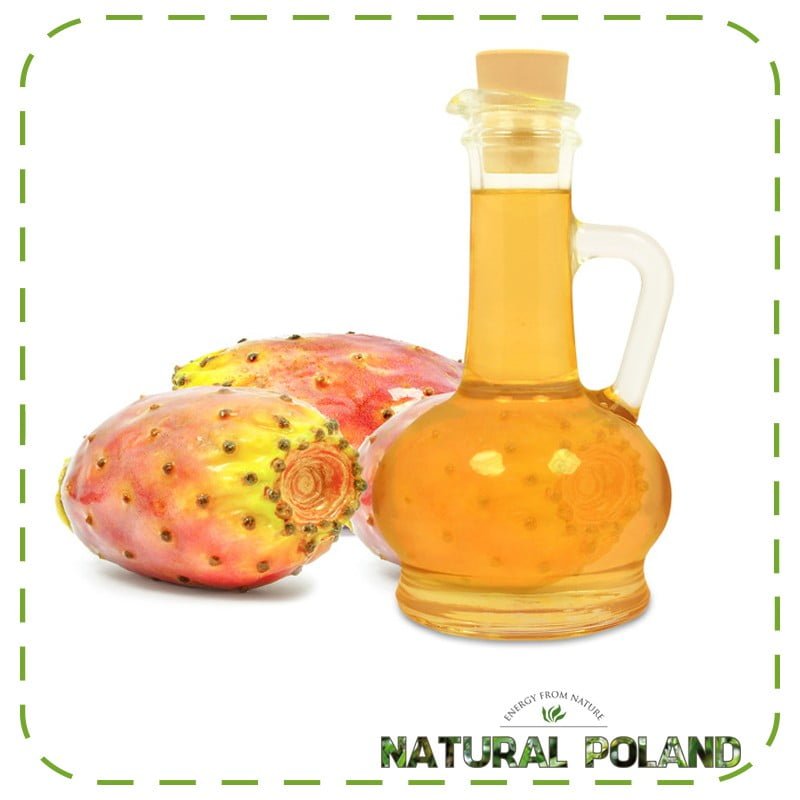Production of fig opuntia oil
Fig opuntia oil is produced from the many small seeds derived from a large, prickly, pear-shaped berry. Relative to the place of origin and the plant species, its fruit may be colored white, dark red, yellow, or even purple.
The oil is pressed manually, which makes the whole process time-consuming and rather inefficient, because opuntia’s seeds contain very little oil. To obtain 1 liter of the prickly pear oil requires about 1 million of the tiny seeds coming from 500 kg of fresh fruit. It makes the oil very expensive.
Fig opuntia oil– the antioxidant properties
The prickly pear oil has very strong antioxidant properties thanks to its vitamin E contents. Comparative studies of oils coming from two species of fig opuntia – Opuntia ficus indica (OFI) and Opuntia Dillenii(OD) – showed the presence of vitamin E in the form of γ-tocopherol (7,8-dimethylotocol), in the respective concentrations of 1.23% and 0.29%. This free radical fighting action is attributable primarily to the presence of the hydroxy group (-OH) in the chromanol ring. Tocopherols’ antioxidant activity in vivo changes along the following sequence: α-T > β-T > γ-T > δ-T, whereas in vitro the sequence is reversed: δ-T > γ-T ~ β-T> α-T.

Prickly pear oil
We are a wholesale distributor of natural prickly pear oil (Prickly Pear Cactus Seed Oil). It is one of the most valued raw materials in the cosmetic industry, known for its exceptional effectiveness.
Vitamin E has anti-aging properties because its compounds – tocopherols and tocotrienols – neutralize free radicals which have adverse effect on elastin and collagen fibers, as well as reduce the amount of lipids in the skin.
Moreover, fig opuntia oil contains the characteristic red pigments, the so-called betalains, which also have antiradical properties. As in the structure of vitamin E, the activity of betalains in binding and neutralizing free radicals is enabled by a hydroxy group (-OH).
Unsaturated fatty acids
Depending on the species it has been pressed from, the fig opuntia oil contains many valuable fatty acids. It has remarkably high contents of polyunsaturated linoleic acid – 60-80% of the oil’s composition. The contents of oleic acid, on the other hand, is about 22%.
Prickly pear oil also contains the following acids: palmitic, stearic, palmitoleic and linolenic. The high contents of the linoleic acid (ω-6) supplements lipid deficiencies in the skin, supporting regeneration of the epidermis and improving skin moisture and elasticity.
The high contents of vitamin E in the oil ensures that the fatty acids are stable and resistant to oxidation. The high contents of sterols (phytosterols), on the other hand, has the effect of strengthening the epidermis barrier and prevents transepidermal water loss (TEWL). The compounds also have anti-allergic and anti-inflammatory properties.
Summary
The fig opuntia oil has antioxidant properties, which make it a valuable ingredient of anti-aging cosmetic products. Its natural origin makes it a fine feature of plant-based skin care routines.
Literature:
- https://biotechnologia.pl/kosmetologia/olej-z-pestek-opuncji-i-olej-z-pestek-sliwek-dwie-nowosci-od-natural-sourcing,9492
- https://issuu.com/39879/docs/swiat_przemyslu_kosmetycznego_1_201/51
- https://orbi.uliege.be/bitstream/2268/156950/1/Ghazi.JMaterEnvironSci.2013.pdf
- http://miesiecznikchemik.pl/wp-content/uploads/2015/02/chemik_2014_07-1.pdf


